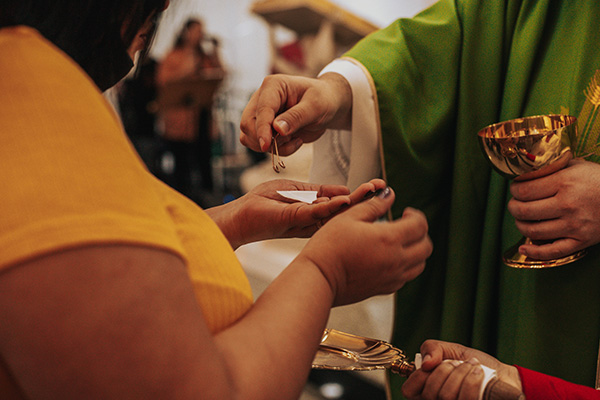
WINDSOR TERRACE — Sometimes, a pastor has to be a traffic cop.
Holy Communion is a sacred part of the Mass, and pastors in the Diocese of Brooklyn carefully plan how the Eucharist will be distributed to the faithful to make sure the procedure goes smoothly, with no logjams in the church aisles.
“It’s a procession. You want it to move slowly and reverently,” said Father Michael Louis Gelfant, pastor Blessed Trinity Parish, Breezy Point. “You don’t want it to be like a ticket line. At the same time, you want it to flow.”
Pastors consider several factors when deciding on the logistics of Communion distribution — the church’s layout, the width of the aisles, the number of parishioners attending Mass — before mapping out a procedure.
At St. Sebastian Church, Woodside, Father Patrick West has the congregation approach the altar by coming up the side aisles rather than the center aisle. Then, once they receive the Eucharist, they walk down the center aisle to return to their pews.
“The center aisle is wider than the side aisles. For logistical purposes, we have them come up by the side aisles and return to their pews by the center aisle,” said Father West, the church’s administrator. “If you had them come up the center aisle and go back by the side aisle, there would be a logjam in those aisles.”
When churches first reopened during the pandemic, Father William Smith, pastor of St. Charles Borromeo Church, Brooklyn Heights, started the Communion line from the back of the church instead of having people sitting in the front pews come up first.
“For a while, we were going from the back because it was easier to maintain the six-foot social distancing between people,” he said.
The church has since returned to a front-to-back policy. “Now. we’re having rows coming up the center aisle and returning by the side aisles,” Father Smith said.
While parishioners are used to the procedure, St. Charles Borromeo attracts many non-parishioners to its 7 p.m. Mass on Sunday evenings. Father Smith always makes sure an announcement is made so newcomers know the drill.
That 7 p.m. Mass is known as the “last-chance Mass” because it is the latest Sunday Mass in English in any church in Brooklyn. People come from all over to attend, especially those spending weekends outside the city who don’t return until early evening.
Msgr. Guy Massie, pastor of Sacred Hearts and St. Stephen Church, Carroll Gardens, meets his parishioners halfway.
He brings the Eucharist midway up the center aisle to distribute Holy Communion to parishioners in the back pews. At the same time, the parishioners in the front part of the church walk up to the altar where a eucharistic minister distributes Communion.
“We split the church in two. We determined it’s the most expedient way to do it without any confusion,” he said.
There’s another reason Msgr. Massie goes halfway up the aisle. “I think, as the celebrant, I don’t want to be so far from the people in the back. I’m in the front for most of the Mass. For the people in the back, I should be present also,” he said.
Blessed Trinity Parish comprises three churches — St. Genevieve, St. Thomas More, and St. Edmund — and Father Gelfant said two out of the three go front-to-back.
“At one of the churches here, St. Genevieve in Roxbury, Communion is from the back to the front,” he said. Longtime parishioners told him that it works best. “They claim, logistics-wise — because it’s such a tight church, a very small church — that it allows for people not to step on each other as they’re trying to get back from Holy Communion.”
Pastors are constantly observing the human traffic flow to see if adjustments are necessary.
“Basically, you look at the flow of the church,” Father Gelfant said. “You want people to move in circles. The goal is to get them out, come up, and to return back to their seats in a circle, without having to cross other people.”
